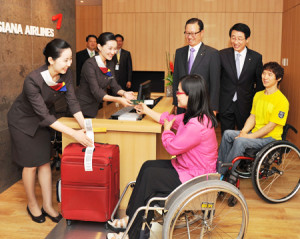Airlines and Passengers With Disabilities
Over 40 million Americans have disabilities. The Air Carrier Access Act and the Department of Transportation (DOT) rule that implements it set out procedures designed to ensure that these individuals have the same opportunity as anyone else to enjoy a pleasant flight. Here are some of the major provisions of the rule.
- A person may not be refused transportation on the basis of disability or be required to have an attendant or produce a medical certificate, except in certain limited circumstances specified in the rule.
- Airlines must provide enplaning, deplaning and connecting assistance, including both personnel and equipment. (Some small commuter aircraft may not be accessible to passengers with severe mobility impairments. When making plans to fly to small cities, such passengers should check on the aircraft type and its accessibility.)
- Airport terminals and airline reservations centers must have TDD telephone devices for persons with hearing or speech impairments.
- Passengers with vision or hearing impairments must have timely access to the same information given to other passengers at the airport or on the plane concerning gate assignments, delayed flights, safety, etc.
- Newer wide-body aircraft must have a wheelchair- accessible lavatory and an on-board wheelchair. Airlines must put an on-board wheelchair on most other flights upon a passenger’s request (48 hours notice required).
- Air carriers must accept wheelchairs as checked baggage, and cannot require passengers to sign liability waivers for them (except for pre-existing damage).
- Most new airplanes must have movable armrests on half the aisle seats, and on-board stowage for one folding passenger wheelchair.
- Carriers must allow service animals to accompany passengers in the cabin, as long as they don’t block the aisle or other emergency evacuation route.
- FAA safety rules establish standards for passengers allowed to sit in emergency exit rows; such persons must be able to perform certain evacuation-related functions.
- FAA rules also prohibit passengers from bringing their own oxygen. Most airlines will provide aircraft-approved oxygen for a fee, but aren’t required to.
- Airlines may not charge for services that are required by this rule.
- Airlines must make available a specially-trained Complaints Resolution Official if a dispute arises. There must be a copy of the DOT rule at every airport.
It’s wise to call the airline again before your trip to reconfirm any assistance that you have requested. Check with the TSA web site for the latest security information.











